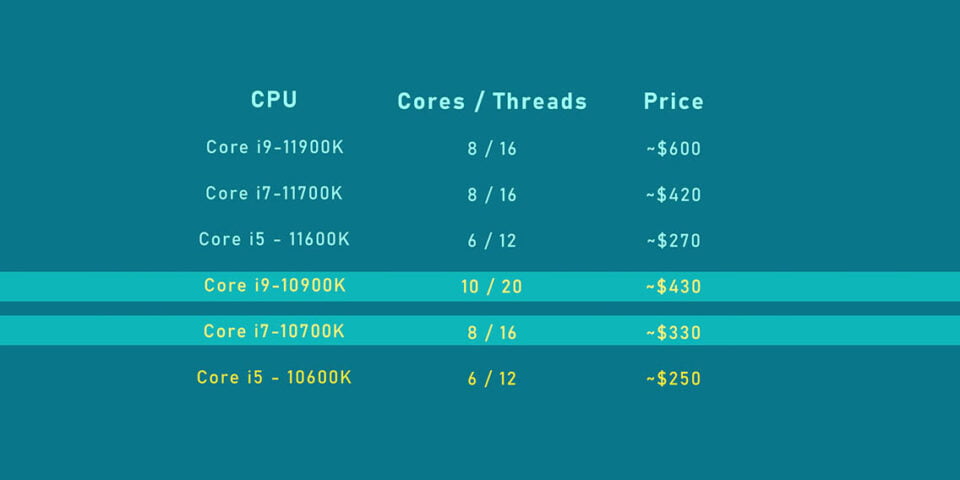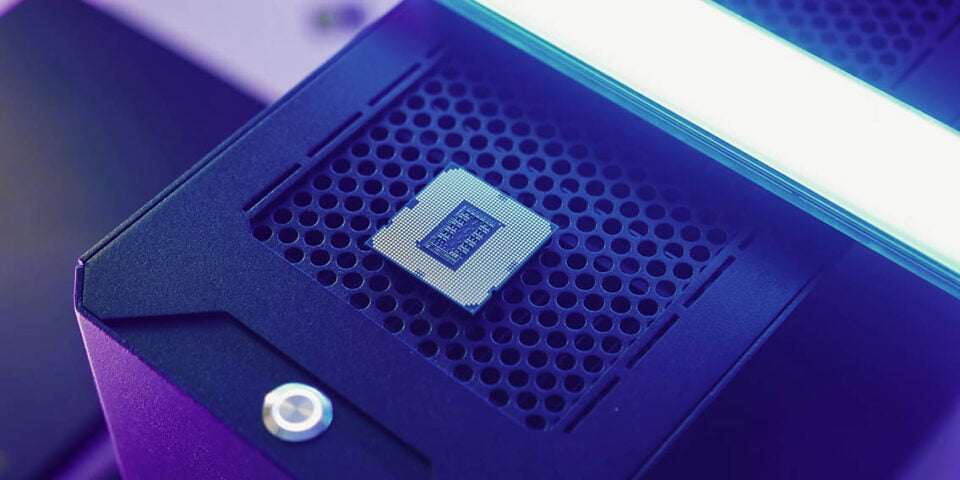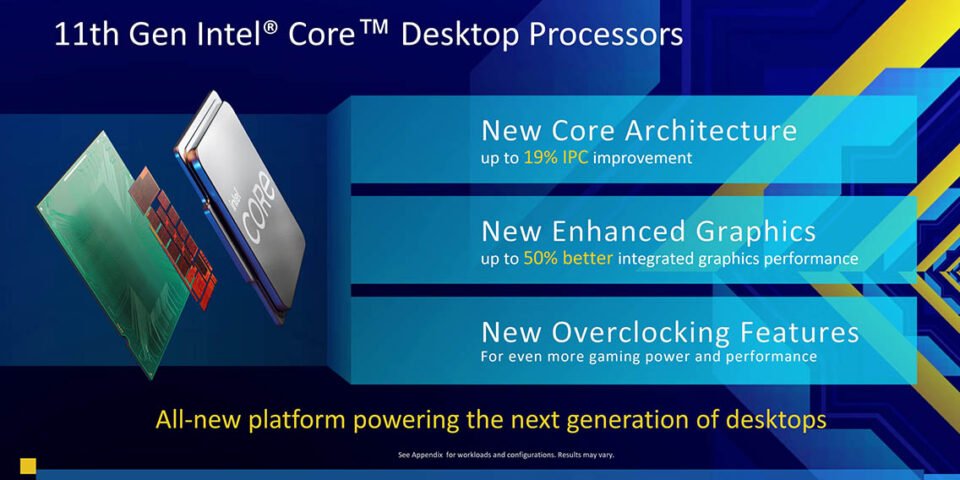Table of contents
Even before Rocket Lake launched it has been like watching a slow motion dumpster fire from Day 1. First, there was Intel’s being curb stomped by Zen 3 last year, then because of a totally broken roadmap they admitted to being forced to use a bizarre mashup of a 2019 microarchitecture with an ancient 14nm manufacturing process.
Not only that, but because of excess heat and power Intel’s flagship CPU – the Core i9-11900K – is back to an 8-core layout. It just doesn’t make any sense. Oh, and then there are some retailers that ended up showing Intel their middle finger and started selling these these chips a few weeks ago. Overall it’s been a disaster so far, but it might not be all bad news though.
While Intel might be looking really weak with their Core i9 and Core i7 range, I actually want to focus this review on the Core i5-11600K. It’s a lot more affordable, sticks to the 6-core/12-thread design, and availability should be much better so there is a real chance that it could put out some of that dumpster fire… maybe.
Core i9-11900K Benchmarks
I mean look the Rocket Lake architecture does show some flashes of really good improvements on the Core i9-11900K, so much so that it can beat the 5900 X in a bunch of real-world applications. However, when it comes to real-world multi-core workloads it just gets beaten like a lazy donkey, even by the previous i9-10900K. Its insane $600 USD street price is even harder to justify in gaming where results are all over the place, and it gets owned by AMD in esports titles as well. And yes there is going to be times where the older i9-10900K comes out on top as well. Now does this look like a $600 processor? Absolutely not, but maybe retailers are hoping that people will buy anything these days since Ryzen 5000 series are just still very difficult to buy. Now all the negative coverage of the i9-11900K might make you think that Intel’s entire lineup is a failure, but it really isn’t, which is exactly why I think the i5-11600K is so important.
Models & Price
To set the stage, let’s take a quick look at Intel’s new Core i5/i7/i9 lineup, along with the approximate street prices we have seen so far. Based on this list you can already see why the i9-11900K is in a bit of a tough position. While it generally has higher clock speeds than the i7-11700K, the core count is identical ad like I said a huge step back from the 10900K. Meanwhile, the other two K series chips fare just a bit better since they haven’t been down a lot. The main problem is pricing, but then again when hasn’t that been an issue for Intel.
You see because of AMD’s Ryzen 5000 series spanking them so hard, Intel had to drastically cut the costs for the i7-10700K and especially the i9-10900K, which leads to a massive price gap between the current and new CPUs. Remember those results I showed you at the beginning of this review? Yeah, Intel is asking $170 USD more for their new flagship with 2 cores less cores, which makes the i9-11900K a complete waste of money. But the new i5-11600K is still close to the i5-10600K’s current price, because it has the same number of cores and the new Cypress core architecture, which should bring some pretty good performance uplifts.
New Core & Features
Now I may as well talk about this new architecture. Cypress Cove is Intel’s first new core design for desktops since Skylake was released almost 6 years ago. Now to create it Intel took the 10nm Sunny Cove architecture – which we have seen on Ice Lake laptop chips – and then backported it to their 14nm manufacturing process. On the positive side, it finally allows Intel to move towards something other than an evolved half-decade old design. But, and this is important, Sunny Cove was a bit of a disaster on the performance side, which is why Intel moved so quickly to the Willow Cove design last year.
So with this new architecture spicing things up is there anything else to be excited about? Well I think the biggest changes to have been the new native PCIe Gen4 for storage and discrete GPUs, Thunderbolt 4, and then an updated iGPU that uses Intel’s new XE graphics engine, and that’s pretty much it.
Compared to Ryzen 5000 Series
Looking at how the i9-11900K lines up with the 5900X makes it super evident why Intel needs a reality check. If you can actually find one the AMD processor can deliver more cores, more performance, and lower power levels for less money. However, AMD’s main problem is that they can’t seem to produce enough CPUs, so if Intel can jump in with actual stock they might actually win by default. This is exactly why we think the i5-11600K could be a real gem. It costs less than the 5600X, still offers 12 threads, and our retail contacts tell us that it will be mostly widely available as well.
While Intel has worked really hard to make all the CPUs appear different, they are actually identical in one big way: Every Rocket Lake has chip comes with the same 8 core die with 2 cores disabled for the 6 core models. That means that every one of them has the same huge die. We know the die is huge because user MoeBen on the Overclock.net forums delidded his i7-11700K and well it’s very, very big or about 33% larger than the 10-core i9-10900K Comet Lake die, and over 50% bigger than the 8-core i9-9900 K.
Power / Temperatures / Frequencies
Now all of that space and Intel’s failure to move past the 14nm manufacturing process should lead to some higher power consumption and heat output, right? Well we actually found something really interesting while testing the i5-11600K. You see Intel’s long duration PL1 and short-term PL2 ratings are pretty well known, and we are seeing them here with the i5-11600K hitting nearly 160W for 80 seconds during an all-core load. It then falls to Intel’s 125W spec. That is a whole lot more than the 10600K and in an other world versus the 5600X. With a Noctua NH-U12S running at 75% fan speed the i5-11600K’s temperature does increase, but it cuts down to more manageable levels over the long run. It’s only 5°C hotter than the 5600X, which isn’t all that bad when you consider the rumors that had these chips putting out gobs of heat.
So this one’s interesting, even though it consumes a lot more power and produces more heat then the i5-10600K the new Rocket Lake CPU actually levels out at much lower all-core frequencies. That short frequency spike at the beginning of the test is meant to make Intel CPU’s look much better in shorter synthetic benchmarks, and obviously that has no impact on longer renders.
Benchmarks
Before moving on to benchmarks, I need to mention that we are sticking to mostly real-world testing with workloads that have been submitted by people who work with these applications on a daily basis. The only synthetic benchmarks we use is Cinebench, and these multi-core tests show a really, really impressive improvement over the previous generation. It could be due to the fact that the i5-10600K boosts for a shorter period of time, but even then Intel still has some catching up to do versus AMD. Now when it comes to single core performance, Rocket Lake’s Cypress Cove cores are well-designed for single core workloads, but Zen 3 dominates here too.
Moving on to actual real-world use cases, and the i5-11600K starts off really strong. I should also mention Premiere’s latest update doesn’t use Intel’s graphics anymore, but rather pushes the NVIDIA GPU to do all the encoding and decoding. Meanwhile programs like Reality Capture and Metashape use a combination of lightly and heavily threaded workloads to process scenes. They show the i5-11600K to be really well-positioned against the 5600X. As a matter of fact, Intel runs away with this sometimes. Our Mozilla compiler test shows that entails actually been able to cox a good amount of improvement from Rocket Lake, and that’s all it took to beat AMD by a narrow margin. Now what really surprised me was even in heavy multithreaded situations the i5-11600K ended up being competitive all, while running at lower speeds than the i5-10600K. Remember this CPU actually costs less than the 5600X, and in most situations it either matches or beats it. As I mentioned at the beginning of this review, this might be the gem in Intel’s lineup right now.
Gaming Benchmarks
But what about gaming performance? Well that’s a tough one, because the i5-11600K is all over the place. It does give some tangible benefits over the previous generation, which is a good thing, but the Ryzen 5 5600X is able to stay pretty far out front in some cases. There are two huge concerns for Intel. First of all, the benefits of Rocket Lake we saw in productivity are nowhere to be seen here, and secondly AMD just clobbers them in some popular competitive shooters.
Overclocking
Now moving on to overclocking and I need to mention that Rocket Lake’s clock speeds have come down a little bit compared to the previous generation… and voltages have gone up. The great thing about Intel’s amazing 14nm process is that it’s really durable and resistant to damage from voltage. The bad news is that it really needs a lot of it to hit higher clock speeds, especially with this new architecture. And given how Intel so desperate to close the gap to AMD Ryzen 5000 series it should come as no surprise that Intel is pushing these new processors to the limit right out of the factory. That means a ton of voltage is being pumped through them. To prove that here are the stock voltage and frequency curves Intel programmed, and you can see that once you reach 4.8GHz you need a lot of voltage. And if you want to reach 5GHz on something like the i9-11900K you will need a lot more. So far in our testing it seems like most Rocket Lake processors will be able to hit 5.1GHz, on some chips that is going to be only on 1 or 2 cores like on our i5-11600K.
Let’s take a closer look at the CPU overclock. With 1.34V, it can run at 5.1GHz on 2 cores for lightly threaded applications, 5GHz on 3 cores, 4.9GHz on up to 5 cores, and then 4.8GHz on all cores for fully multi-threaded applications. That is only a 200MHz overclock, and it was able to push the package power from 125W to 192W. Temperatures went all the way up to 89°C in AutoDesk Maya, and we were using a Noctua NH-U12A with 2 fans running at full speed. This means you are going to need an excellent cooling solution to keep this chip running under 90°C when it’s overclocked. Now we are going to get into more detail about overclocking and memory tweaking and all that stuff in an upcoming article, but here is a little teaser so stay tuned for that.
Conclusion
I guess that pretty much wraps things up with the i5-11600K, and well I have a lot of mixed feelings about this one. My thoughts are a lot more positive than the i9-11900K, because while that processor is overpriced and underperforming and just an all around dumpster fire, I think the i5-11600K is a pretty decent chip. It improves big time over the i5-10600K and it either equals or beats the Ryzen 5 5600X in a lot of apps while costing a lot less. It’s a great all around option that shouldn’t have any of the supply issues that AMD’s unfortunately facing right now with their Ryzen 5000 series.
The problem is with gaming, and I never thought I would say this but Intel actually still needs to work on their gaming performance, especially when it comes to competitive shooters. In new AAA games that are GPU bottlenecked the i5-11600K is just as good as the 5600X, but move to something like Rainbow Six Siege, Valorant, and CS:GO and the tires just fall right off. Those aren’t unpopular like Tomb Raider, Hitman, and other games that everyone else loves benchmarking. Those competitive esports titles host hundreds of thousands of concurrent users that AMD found this secret sauce for them, and now Intel needs to pull up their pants and work really fast to do the same. Either way, given its price I would say the i5-11600K is a great alternative to the 5600X in almost every situation. I’m just going to hope that it stays in stock long enough for people to actually buy one.



















